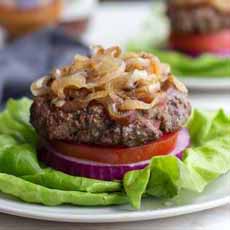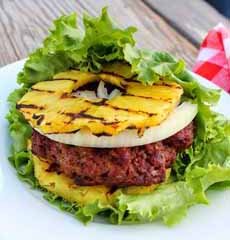TIP OF THE DAY: Bunless Burgers
|
Most store-bought burger rolls are pretty blah: a form of white bread used to hold the burger. Earlier, we suggested 25+ alternatives to the burger bun, from baguette to brioche to pretzel roll. Even when the roll is special, it begs the question: Does the bread serve any purpose other than enabling utensil-free eating? We love good bread: At a top restaurant, we’d rather have the bread than the meat. But over the years we’ve found that it doesn’t add to the burger experience. Even the best bread gets soggy with all the condiments and burger juice. Drumroll: Today, we suggest burgers without the bun—at least, without a bread bun. The original hamburger steak served in the U.S., essentially the Hamburg steak from Hamburg, Germany, was served on a plate with a fork and knife: no bun (here’s the hamburger history). So how about going bunless—or rather, breadless? Whether gluten-free, low-carb or paleo, we’ve seen every burger bun substitute imaginable, from homemade cauliflower buns to potato pancakes. Alternatives To The Burger Bun Look to different vegetables: Otherwise, you may end up with sliders. TIP: While bread buns keep your fingers clean, the lettuce leaves do the same (at best a bit of water residue). If you don’t want to touch the oil-brushed grilled veggies, the solution is simple: an open-face burger with a knife and fork. We enjoy trying new burger toppings. These work whether you serve conventional buns or the “vegetable buns” above. You can start with your favorite condiments (ours are curried ketchup*, sriracha mayo* and sweet and savory pickles). If you call yourself a foodie, bypass the commercial cabbage slaw with a few flecks of carrot, dripping with diluted mayonnaise. Instead, go for a homemade slaw. If you don’t have time to make it, assign one or two recipes to someone else.
|
|
|
|
BUNS, ROLLS AND BISCUITS: THE DIFFERENCE Are the halved breads that surround hot dogs and hamburgers properly called rolls or buns? There is no official difference, meaning that there are no specific USDA standards. Both rolls and buns are single-serve breads, and the USDA only stipulates that buns and rolls weigh less than one-half pound. (Loaves of bread, on the other hand, must weigh one pound or more). Manufacturers and retailers use whichever term they want. However, the American Institute of Baking uses this distinction Just for the record. ________________ *Just mix the seasoning into regular ketchup or mayonnaise to your desired intensity. |
||







